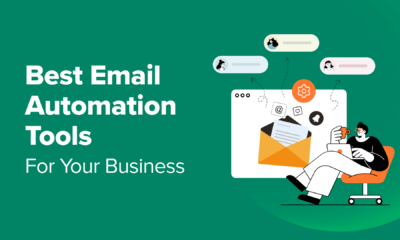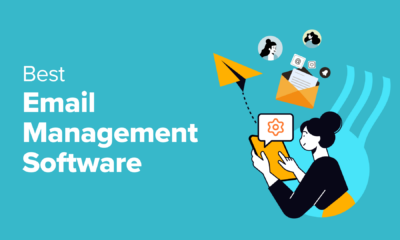MARKETING
The Five Things to Think About For Your 2022 Marketing Budget

This time last year I was telling anyone who asked my opinion to think long term: Don’t cut marketing spending. Invest wisely. Yes, times are scary, but it is the firms that lean into their brand and digital presence that are going to emerge in a better place than those that do not.
Some firms listened. Others didn’t.
With 2022 fast approaching, it’s time to take stock of your firm’s marketing health. The longer you wait to make investments in critical marketing initiatives, the further behind your competition you will be. And take it from me: smart, forward-thinking firms are investing in marketing right now.
So, where should you focus your marketing dollars?
Marketing Automation
First and foremost, you need to invest in marketing automation tools. Marketing automation is the process of making repetitive tasks more efficient with tools like email marketing platforms, social schedulers, etc.
There are some things a human being should always be the one executing. But pushing “send” on a marketing email at a specific time, posting to your company’s twitter feed, or making a blog post go live? Nope.
“I’ve already got a social scheduler and email marketing platform,” you’re saying. Great! Now it’s time to kick it up a notch. What type of communications do your website visitors receive when they download a resource from your site?
Notice I said communications. A single “thanks for downloading” email isn’t enough. Setting up automations to nurture those contacts is simple and truly takes just a little bit of time.
Imagine: Visitor registers for a Trusts and Estates virtual CLE you are running. Once they register, they get an email thanking them for their registration, and they are entered into a workflow so that they also receive subsequent, tailored emails on trusts and estates and other related topics every three to four weeks. Enrollment in this workflow is triggered simply by signing up for the event. No further manual action required. Until they reach out for more information on your services that is.
Resources Required:
- Graphic designer
- Marketing technologist
- Project manager
- Marketing automation tool
Time Required For:
- Researching the options available in the tools you have or new resources.
- Creating automated emails from existing content and/or templates for new content as it is generated. (~30 mins/email)
- Designing automated email templates. (~30 mins/email)
- Setting up workflows. (Depends on the complexity of the workflow, but could be as quick as 5 minutes once you have all the right pieces in place.)
Multimedia Marketing
Call me captain obvious, but videos and podcasts are an increasingly valuable and important marketing method in your toolbox. And right now we’re in a great spot to be producing quick hit, high-value multimedia content. It doesn’t take much more than a ring light, a usb lavalier microphone, and a decent webcam (or your smartphone) to become a livestream or podcast producer. No one is expecting perfection.
“Do I have to?” No, you don’t have to. But here are some reasons why you really should:
- A one to three-minute video on social media gets your brand and your content in front of your audience in a method they are accustomed to consuming.
- Adding video to email can increase click-through rates by 200%+
- A video is 50x more likely to appear on the first page of Google search results, especially when it’s a YouTube video.
- 94% of video marketers say video has helped increase user understanding of their product or service.
- 68% of consumers say the pandemic has impacted the amount of video content they’ve watched online, with the overwhelming majority (96%) saying this has increased.
- 84% of people say that they’ve been convinced to buy a product or service by watching a brand’s video.
“When asked how they’d most like to learn about a product or service, 69% [of respondents] said they’d prefer to watch a short video. This compares to 18% who’d rather read a text-based article, website, or post, 4% who’d like to view an infographic, 3% who’d rather download an ebook or manual, and 3% who’d rather attend a webinar,” says Wyzowl.
What does take time is the planning and distribution of this content. Invest in resources — either internal or external — that can help you put together content that can be used multiple ways, multiple times.
Resources Required:
- Lighting for each contributor like this ring light from Amazon. This is another good option for on-the-go. (I have both)
- A decent microphone for each contributor. This lavaliere mic works with a standard audio jack, or has an iPhone lighting port adapter. Another good option is this Shure microphone. (Again, I have both.)
- Video and/or audio editing software OR an outsourced editor. You’d be surprised what you can do in Canva with video, but this is a truly worthwhile external investment.
- A place to host videos (YouTube works great) and/or Podcasts (Libsyn, BuzzSprout, and Soundcloud are all good options depending on what you want to achieve.)
- Royalty-free music (I recently subscribed to Artlist and I’m very happy with the options available. They also pre-test music for YouTube copyright passability.)
- Graphic designer for intro/outro if your outsourced editor is unable to provide.
- Video caption creator.
Time Required For:
- Recording videos. Start with one-hour blocks and try to get enough content for three to four one-minute videos. (1 hour/recording.)
- Designing video intro/outro (Varies)
- Researching content and writing scripts (Varies)
- For video: reviewing captions and editing transcript (Depends on length of content.)
- Posting transcript to website (15 minutes)
- Related email, social, and other promotion (varies)
Integrated Systems
I’m going to go on record right now and tell you there are dozens, if not hundreds, of tools that all do kind of the same thing when it comes to marketing automation. I couldn’t possibly compare all of them for you, but here is what I will say: At the heart of what you should be doing is connecting all of your marketing functions to your Client Relationship Management (CRM) tool.
CRMs and their connected marketing platforms today are not the tools they were 10 years ago. Fully integrated systems today can and should be the hub of all marketing activities, helping you attract attention, validate your presence in the marketplace, and convert prospects into clients.
Why is this important? When you have a fully integrated marketing ecosystem, your web traffic, social performance, business development pipeline, email marketing, and contact database all live in one place. This means you can better track your marketing efforts and reach your target audiences efficiently and effectively.
We at LISI are big fans of HubSpot, but like I said, there are other tools that might get the job done.
Resources Required:
Time Required
- System configuration
- Template migration
- Contact migration
I won’t lie, this is going to take a lot of time. This is not a project you’ll enter into lightly, but I promise you, you won’t be sorry you did.
Branding and Marketing Messaging
Is your brand tired? Does your visual representation in digital and print reflect where your firm is today? Sometimes it’s just time for a refresh. Nothing is necessarily “wrong,” but your brand is outdated. That’s a subliminal message to prospects that your firm isn’t investing in itself. In technology. In systems and processes. That you’re slow to change.
Resources Required:
- This is one of those times you need to bring in an outside perspective. Depending on how deep of a dive you decide to do, this can range from brand ‘lite’ to full brand overhaul.
- Graphic designer (internal or external)
Time Required For:
- Conducting stakeholder interviews
- Conducting client interviews
- Doing a comprehensive brand audit
- Creating a new Brand
- Creating all the “things” that go with a new brand
In total, this can take 3-6 months for a comprehensive process. I recommend ensuring you’ve got all your stakeholders on board so this doesn’t drag out. You want these conversations to be fresh in people’s minds and reasoning behind decisions to be clear.
Omnipresent Digital Presence
I read this term recently and it really resonated with me. Having an omnipresent digital presence means being present across all the appropriate channels for your brand, consistently. This requires diligent strategic planning, consistent content production, and coordinated efforts across each platform.
In practical terms this means:
- Focusing on Search Engine Optimization (SEO). Optimizing your website for organic search is a critical first step. Whatever type of law you practice, when someone searches for information about that area online, you want to be front and center. Ranking high on search engine results pages (SERPs) is a long game, but having a coordinated strategy to get you there starts with the first step.
- Investing in Pay-Per-Click search engine marketing (PPC SEM) if warranted for your practice. Essentially all consumer-facing practices need to invest money in targeted PPC. Why? Because SEM completely changes the face of digital marketing and if you don’t show up in ads at the top of the SERPs, you’re missing out on business. Plain and simple.
- Putting a mechanism in place to generate content consistently. Two to four valuable pieces of content per month, depending on your practice. I’m talking about guides, infographics, videos, podcasts, FAQs, blogs. How? Pick a broad topic, then make a list under that topic heading of all the things that could fall under that topic. Then plan out a content generation plan to address each of those items. Vary your mediums.
- Creating a social media strategy. Think about the audience on each platform. On LinkedIn, for example, you’ll go for referral sources and professional contacts. Twitter, possibly media sources, or clients looking for news. Instagram is for the softer side/behind the scenes. Pick the platforms that make sense for your audience and tailor your content accordingly.
Resources Required:
- A digital marketing specialist who knows what they’re doing re: SEO/SEM. You might have this resource internally, but if not, you’ll need to hire someone to help you with this.
- A content specialist. Someone who can create the strategy and execute production, whether as a project manager, or as the person who is actually producing it herself. Again, this could be done internally depending on your staffing, but is a good place to outsource.
- A social media strategist who can create the strategy and tailor content for each platform.
Time Required For:
- Creating content (3-5 hours/piece)
- Optimizing your website for SEO (varies depending on how many pages your site has.)
- Creating SEM campaigns (varies)
- Creating social media (10-20 hours/month or more)



















You must be logged in to post a comment Login